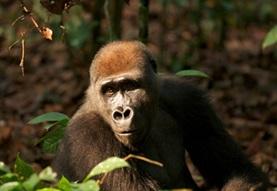
As part of the GEF Congo Basin Integrated Programme, and together with partners, the UNEP-led Congo Basin Sustainable Landscapes Programme is tackling the drivers of deforestation and forest degradation by working with local communities to develop integrated transboundary land use management plans that are designed to support biodiversity and conserve forest cover, while ensuring livelihoods remain sustainable and economic opportunities increase for forest dwellers.
Great ape conservation to increase biodiversity in the Congo Basin is thus a focus of the Programme. Great apes support biodiversity and help maintain the ecological balance, as they play vital roles in seed dispersal and forest regeneration. However, habitat loss due to logging, agriculture, and mining is a significant threat to their survival. The Western Lowland Gorilla pictured here (photo credit: Johannes Refisch) increases biodiversity in the Congo Forests, by, for example, dispersing seeds and creating gaps in the forest canopy, increasing light and thus supporting life in the Forests.
The global demand for palm oil, projected to grow by a minimum 50% by 2050, is one such driver of habitat loss in great ape ranges in the Congo Basin. The region is highly suitable for the cultivation of oil palm increasing pressure on forest biodiversity in the region. Large areas of great ape ranges in the Congo Basin, for example, are outside of protected parks and are suitable for palm oil production.
Accurate maps are therefore needed to understand trends in oil palm expansion for landscape-level planning, conservation management of Endangered species, and supply of ecosystem services. While some maps showing where oil palm is growing are available for some of Africa, such maps are not available for Central Africa.
The study Mapping oil palm plantations and their implications on forest and great ape habitat loss in Central Africa (Ozigis et al, 2024), produced by UNEP’s partner Liverpool John Moore’s University under the UNEP-led GEF Congo Basin Integrated Programme, is helping bridge the gap.
The study produced the first regional scale oil palm map for Central Africa, the first mapping forest loss within great ape ranges, and further established forest loss owing to oil palm. Target countries were Cameroon, Central African Republic, Democratic Republic of Congo, Equatorial Guinea, Gabon, and Republic of Congo.
The study results suggest that oil palm expansion has caused a small proportion of the total habitat loss and thus indicates that other drivers of deforestation are having a bigger impact on great ape ranges. However, while oil palm may not yet be the main driver of forest cover loss within great ape ranges presently, oil palm cultivation in the region has witnessed exponential growth through forest clearing, and the increased global demand for vegetable oils may exacerbate this. Within the palm oil sector, small -holder production plays a significant role.
Other key results include the following:
- Undisturbed tropical moist forest (TMF) in great ape ranges had significantly reduced by 177,000km2 (that is half the size of Germany) between 2000 and 2021.
- A total of 1,700km2 of the undisturbed TMF was converted to oil palm by 2021.
- Over 1,000km2 of forest within great ape ranges have been converted to oil palm between 2000 and 2021.
- Oil palm covered a total area of 3,740km2 ± 2,000km2 within Central Africa
- Smallholder Oil Palm (SOP) had a total area coverage of 1,290km2 ± 400km2 (41%), while Industrial Oil Palm (IOP) plantations had a total area coverage of 2,450km2 ± 1,600km2 (59%)
- Oil palm cultivation across the target countries combined occupied a total of 5.6% of the total agricultural land for Central Africa, and accounted for ~1,800km2 of forest loss in the 20-year period assessed.
- Cameroon had the highest area of both SOP and IOP, with a total of 1,900km2 ± 50km2
- Equatorial Guinea has the least oil palm surface area with a total of 10km2 ± 2km2 (SOP and IOP)
This study provided the first regional scale oil palm map for Central Africa, mapped forest loss within the great ape ranges, and further established forest loss owing to oil palm. While it was observed that oil palm conversion to forest may not necessarily be a significant driver of this sharp deforestation at this point, the authors concluded that research is certainly needed to help improve our understanding of other drivers, such as small-scale agriculture, infrastructural development in general and the impact on great ape ranges within Central Africa.
Full study can be found here.
Ozigis, M.S., Wich, S., Descals, A., Szantoi, Z. and Meijaard, E. (2024). Mapping oil palm plantations and their implications on forest and great ape habitat loss in Central Africa. Remote Sens Ecol Conserv.
About the Programme
The GEF-funded Congo Basin Integrated Programme, being delivered under the UNEP-led multi-country and multi-partner Congo Basin Sustainable Landscapes Programme, comprises two flagship initiatives, including the GEF-7 Congo Basin Impact Programme running from 2021-2026, and the GEF-8 Congo Critical Forest Biome Integrated Programme from 2025-2030. These are both flagship initiatives of the UNEP-led multi-partner and multi-country Congo Basin Sustainable Landscapes Programme. The main aim of these two GEF-funded initiatives is to catalyse transformational change in conservation and sustainable management of critical forests in transboundary and national landscapes of the Congo Basin. More information about the Congo Basin Sustainable Landscapes Programme here.
